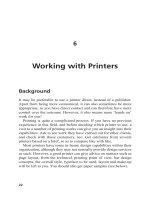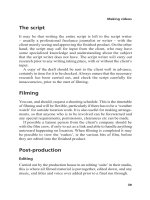Evaluation of Print Media
Bạn đang xem bản rút gọn của tài liệu. Xem và tải ngay bản đầy đủ của tài liệu tại đây (2.19 MB, 24 trang )
Evaluation of Print Media
Evaluation of Print Media
12
McGraw-Hill/Irwin
© 2004 The McGraw-Hill Companies, Inc., All Rights Reserved.
Classifications of Magazines
By Content
By Content
Consumer Magazines
Farm Magazines
Business Magazines
Professional Group
Magazines
Industrial Magazines
Trade Magazines
General Business
Magazines
Health Care magazines
By Size
Large
Flat
Standard
Small or Pocket
By Geography
Local
Regional
National
Advantages of Magazines
¾ Selectivity
¾ Reproduction Quality
¾ Creative Flexibility
¾ Permanence
¾ Prestige
¾ Receptivity, Involvement
¾ Services
Magazines are targeted to specific audiences
Special Magazine Features
¾Bleed Pages
¾Cover Positions
¾Inserts
¾Gate Folds
¾Island Halves
Disadvantages of Magazines
¾ Costs
¾ Limited Reach and Frequency
¾ Long Lead Time
¾ Clutter and Competition
Magazine Circulation
and Readership
¾
¾
Circulation
Circulation
Primary Circulation
Guaranteed Circulation
Controlled-circulation
¾ Readership and Total Audience
Pass
Pass
-
-
along readership
along readership
Total audience (
Total audience (
readers per copy X circulation)
readers per copy X circulation)
Audience Information and Research
¾ Circulation Verification Services
– Audit Bureau of Circulation (ABC)
– Business Publications Audit
¾ SRDS Media Solutions
¾ Syndicated Audience Studies
– Simmons Market Research Bureau
– Mediamark Research Inc. (MRI)
SRDS Media Solutions provides information
on magazine for media planners
Factors determining magazine ad rates
¾ Circulation of the magazine
¾ Color
¾ Size of the ad
¾ Position in the magazine
¾ Special mechanical or production
¾ Number and frequency of insertions
The Future of Magazines
¾ Declining Ad Revenues
¾ Stronger Editorial Platforms
¾ Circulation Management
¾ Cross-Magazine and Media Deals
¾ Database Marketing
¾ Advances in Technology
¾ Electronic Delivery Methods
Most magazines cannot survive without
advertising revenue
Newspaper Overview
¾ The dominant advertising vehicle
¾ Account for 22% of ad dollars
¾ Over 1,400 daily papers in print
¾ Daily circulation over 60 million
¾ Main community medium
¾ Local ads provide 85% of revenue
Newspaper Classifications
Publication Frequency
Publication Frequency
Daily
Weekly
Type
Type
National
Special-Audience
Supplements
Size
Size
Standard
Tabloid
Audience Type
Audience Type
Ethnic, religious
Business, financial
College
Newspaper Advertising
¾ Display Ads
Local (mostly retail)
National or General
¾ Classified Ads
Small items arranged by topic
Rates based in size, duration
Classified display - combination
¾ Public Notices
Legal notices - public reports
Notices by people, organizations
¾ Printed Inserts
Prepared separately by advertisers
Advantages of Newspapers
¾ Extensive Penetration
¾ Flexibility
¾ Geographic Selectivity
¾ Reader Involvement, Acceptance
¾ Services Offered
Section Segmentation
¾ Sports Section
Heavy (down-scale) male readership
¾ Society Section
Heavy (mid-scale) female readership
¾ Financial Section
Appeals to the business reader
¾ Comic Section
Heavy child/adolescent readership
Ads can be run in various sections of most
newspapers
Newspaper Drawbacks
¾ Production quality may be low
¾ Short life span
¾ Lack of selectivity
¾ Clutter
¾ Potential for poor ad placement
¾ Maybe overlapping circulation
Two Ways to Buy Newspaper Space
Agate Lines
Measuring 1/4" deep by 1 standard
column wide
A standard column is usually 2" wide
Column Inch
Column inch is 1 inch deep by 1 column
wide
There are 14 agate lines per column
inch
Rate Terminology
General Rates
Local Rates
Flat Rates
Open Rates
Preferred position
Run-of-Paper (ROP)
Color rates
Combination Rates
Unique Newspaper Features
¾Mass audience
¾Cross-section of population
¾Local geographic coverage
¾Wide range of content, subjects
Selective readership by area
¾Timely coverage, daily issues
¾Readership concentrated in time
The Future of Newspapers
¾ Competition from other media
¾ Circulation management
¾ Cross-media buys with other
newspapers and magazines
¾ Attracting and retaining readers
Newspapers are trying to attract younger
readers









